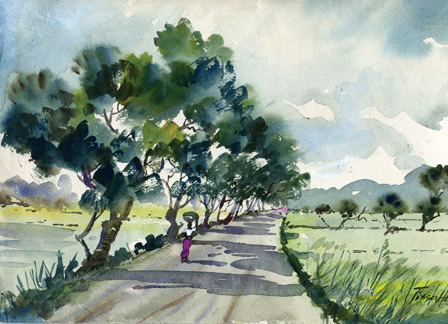Painting a landscape with trees
by Tissa Hewavitarane
The difference between a photograph and a painting is just the
surface appearance. With each stroke of the brush, the artist expresses
his own personality and feelings about the subject. This applies
particularly in a watercolour painting, in which every brush stroke
remains valuable and therefore becomes an intergral part of the finished
product.
Beginners have a tendency to be rigid and flexible in their brush
work due to lack of confidence. Do not be a slave to your subject and
let your enjoyment of it come through in your painting. Remember you do
not have to paint a masterpiece every time. Sometimes it is good to
experiment with new ways of manipulating the brush and paint.
|

Shady trees |
Trees can have many shapes, but they are easily represented with a
simple combination of shadowing. A watercolour must always be painted
from light to dark. After outlining the area where the trees must go, a
light green wash is applied and then the contrasts are put in.
Expressive brush strokes
Various effects can be achieved with a dry brush. A dry brushstroke
on a dry background brings out the grain of the paper creating an
interplay with previously applied coast of paint. A dry brush can be
used to paint over a white surface or one previously tinted with a wash.
The technique of using a dry brush is one of the most interesting ones
that can be performed with watercolour. Naturally it is not something to
be used at all times. Some areas of a painting will inevitably demand
techniques involving the blending of colours or creating gradations.
Landscape
Take the landscape painting I have done titled 'Shady Trees'. The
exercise that follows is a landscape with a group of trees in the
foreground. The greens in the landscape are fresh and vibrant because
the artist has built his colours and tones with lively strokes of dark
green blue and yellow. The painting is sufficiently rich in shades and
textures to allow it to perfectly demonstrate the technique of using the
dry brush. The tree trunks are precisely sketched and the twisted
branches are clearly shown.
Instead of trying to paint individual leaves I have used small flecks
and dabs of paint which indicate clusters of foliage without appearing
stilted. Trees are three dimensional not flat, as they are so often
portrayed. Notice that the trees and foliage are massed into groups of
light and dark tone so that each one registers strongly against the
other.
Warm and cool green built up with transparent glazes give the effect
of sunshine through the leaves. Finally, when all the paint is dry, the
tall grass in the foreground (on the right) is added. Soft flowing
brushstrokes are made at an inclined angle to trace the stalks. The
brush should not be too loaded with paint to allow broken brushstrokes.
The eye is always drawn to human figures in a landscape, and their
inclusion can turn an ordinary subject into a striking picture. Here the
tiny human figure on the left (a woman with a heavy load on her head)
forms the anchoring point for the whole composition. It gives life to
the painting. Harmonious colours and tones give clarity and strength to
the image.
Shadows
Shadows are marvellous devices for conveying an impression of bright
sunshine. Here the pattern on shadows cast by the trees activate the
composition and create a buoyant spring like feel. The area
corresponding to the road is minimally but clearly outlined. Care is
taken to draw the area that differentiates the road from the earth and
its vegetation.
A light purple mixture is used to show the shadows fallen on the
road. Shadows can be used to help build or strengthen a composition.
The pattern of values is well suited for landscape painting. The sky
is very light in value. All horizontal planes, since they are
perpendicular to the source of light, are also very light in value. All
planes that are parallel to the light source do not receive the full
intensity. And there are middle and dark values. So a typical landscape
scene consists of middle values and dark against light values. This is
only a generalisation.
Sky and clouds
When painting the sky it should be planned beforehand-what sort of
weather conditions you are going to have, whether it's a windy, sunny
day with lot of fleecy white clouds, or an approaching storm, or a rainy
day or even a clear blue sky.
My painting shows now the clouds too obey the laws of perspective
appearing to get smaller as they reach the horizon. Even a clear blue
sky should graduate in tone with the colour at the horizon being weaker.
Note how the sky softly graduates from blue at the zenith to pale and
white clouds to the horizon. |

